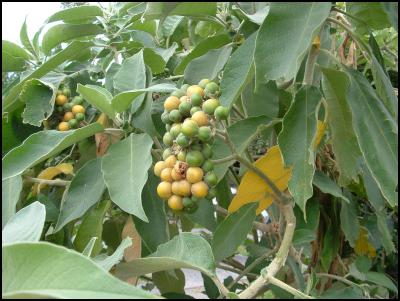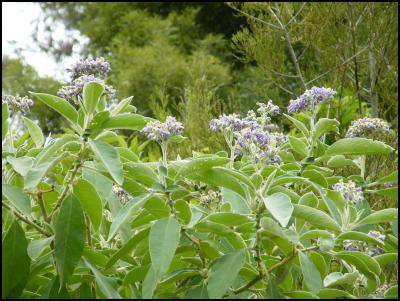Check for Woolly Nightshade
Media Release
9 May 2017
Check for Woolly Nightshade

Woolly nightshade fruit,
photo Weedbuster
Hawke’s Bay residents are asked to check for Woolly nightshade plants in gardens, wasteland areas and roadsides and report any plants found to Hawke’s Bay Regional Council Biosecurity team.
Woolly nightshade is a fast-growing and extremely invasive plant that is widely spread throughout the region’s gardens, roadsides, and rank pasture. It is also a health hazard, as people handling it may suffer nausea and irritation of the skin and respiratory tract.
“We want to keep a check on this plant, especially because of the health concerns. We’ve never found it in huge numbers, but as it will grow almost anywhere in Hawke’s Bay we don’t want it spreading, like it has further north,” says Alice McNatty, HBRC biosecurity officer.
“When people contact us, we’ll come out and kill the plant at no cost to the landowner. We will also advise them on how to control any seedlings that might pop up.”
Ms McNatty says that the shrub is flowering at the moment, so can be more easily identified by its lilac flowers. Some plants may also be fruiting at present and it is important to ensure the berries don’t get into compost or weed piles. Woolly nightshade can quickly grow into a small tree up to 10 metres high and become more difficult to remove, so it is better to identify it and deal with it early.

Woolly nightshade flowering,
photo Weedbusters
Woolly nightshade - also known as tobacco weed, kerosene plant, flannel weed and eared nightshade - can be identified by its distinctive hairy, oval leaves, and small, pretty lilac flowers which are massed in clusters at the ends of branches. It forms green berries up to 18mm in diameter which yellow when ripe. Seedlings that establish in spring can flower by autumn and continue flowering.
Hawke’s Bay residents can report a woolly nightshade plant by contacting HBRC’s Biosecurity team Alice McNatty 06 833 8083 or Louise Hampton 06 833 8023. If staff are unavailable, residents can leave a message including name, phone number and address of the plant location.
More information on this plant and other plant pests is on the national Weedbusters websitewww.weedbusters.org.nz.


 Gordon Campbell: On Luxon’s Survival Chances, And The India FTA
Gordon Campbell: On Luxon’s Survival Chances, And The India FTA New Zealand Government: International Anti-Money Laundering Rule Changes Support Government Reforms
New Zealand Government: International Anti-Money Laundering Rule Changes Support Government Reforms Justice for Palestine: Emergency Protest As Israel Breaks Ceasefire With Deadly Dawn Attacks On Gazan Civilians
Justice for Palestine: Emergency Protest As Israel Breaks Ceasefire With Deadly Dawn Attacks On Gazan Civilians PSA: Internal Affairs Gutted Again With Govt Planning To Cut 133 Roles
PSA: Internal Affairs Gutted Again With Govt Planning To Cut 133 Roles Workers First Union: Our Union’s New Name - ‘FIRST Union’ Becomes ‘Workers First Union’
Workers First Union: Our Union’s New Name - ‘FIRST Union’ Becomes ‘Workers First Union’ Council for International Development: Kiwi Aid Agencies Urge Govt To Increase Climate Finance & Foreign Aid Spending
Council for International Development: Kiwi Aid Agencies Urge Govt To Increase Climate Finance & Foreign Aid Spending RNZ: Luxon Reaffirms NZ's Support For Ukraine After 'Coalition Of The Willing' Call With World Leaders
RNZ: Luxon Reaffirms NZ's Support For Ukraine After 'Coalition Of The Willing' Call With World Leaders


